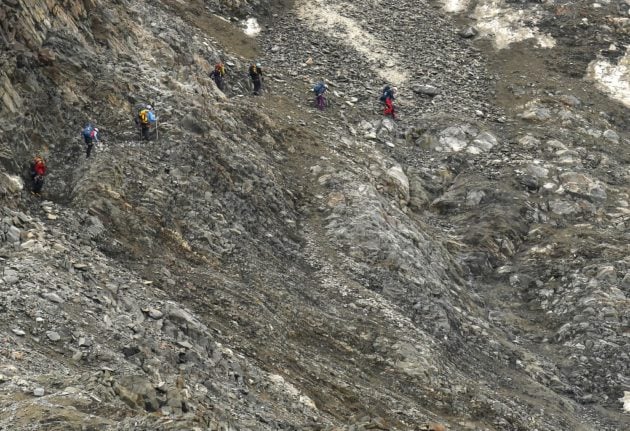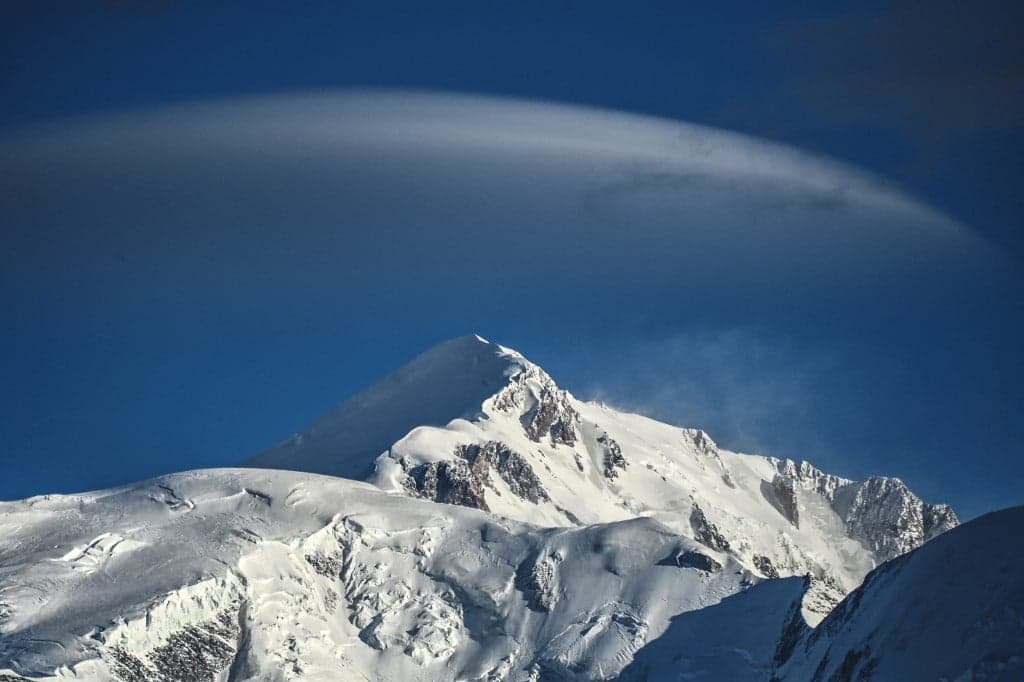Since the early 1990s, an estimated 310 people have died while attempting to summit Mount Everest, the world's tallest peak, standing at 8,848 metres.
Meanwhile, Mont Blanc, located in the Alps, has a little over half the elevation (4,809m) that Everest boasts, but its death count is significantly higher.
Some figures cite an average of 100 deaths per year along the Mont Blanc massif, which could stand to rise as climate change increases the risk of rock falls and avalanches.
The majority of deaths on the mountain happen due to falls, people being hit by rocks, or hikers becoming lost or stranded, media have reported.
In 2023 alone there have already been eight deaths on western Europe's tallest peak that lies along the French-Italian border and stretches into Switzerland. Six people died in an avalanche in April, and another two hikers - one British, one Italian - fell to their deaths in mid-July.
According to the French magazine, Montagnes, there are an average of 770 involved rescue operations in the Mont Blanc area during the peak season (mid-May to mid-October) per year.
In just one Sunday in July 2022, France Bleu reported that rescuers had to conduct over 100 operations. One of those involved sending out eight emergency workers, three doctors and two helicopters to save three hikers who had gone off course, finding themselves trapped 50 metres down the mountain amid boulders and snow.
An analysis of serious accidents along the mountain's dangerous 'Goûter pass' - known colloquially as the 'corridor of death' for its falling rocks - found that over 80 percent of victims were amateurs attempting the climb without a professional guide.

Yet, when searching online for the world's most technically challenging mountains, Mont Blanc rarely even makes the Top 10. Instead, you'll find peaks in the Himalayas, like K2, Annapurna, and Everest, or Denali, the tallest mountain in North America, known for its rugged isolation and crippling temperatures.
In reality, Mont Blanc is more of a moderate-level climb, not intended for beginners but certainly not to be compared to going over 8,000 metres.
So why is Mont Blanc so deadly?
The problem lies with the fact that Mont Blanc is often portrayed as "just a long walk" suitable for anyone in good health and physical condition.
It attracts at least 20,000 would-be climbers per year, many of whom have little to no climbing experience. This is in part due to its convenience - situated at a crossroads between France, Italy and Switzerland with the popular resort town of Chamonix seated at the foot of the mountain.
Freelance writer and pilot, Lane Wallace, wrote in The Atlantic about her 2012 attempt to climb Mont Blanc, after having been recruited to be part of a guided team.
She said: "Only about five of our 22 team members had any climbing experience, and I was not one of them. But I, too, was assured by the guiding company that no previous climbing experience was required. It was really just a long walk, they said, and as long as I was in good physical condition, it would be no problem".
Eventually, Wallace turned around, just above 3,000 metres. She looked at the steep portion ahead of her and realised that she "did not belong on that rock face", having no prior experience with an ice axe or crampons, the traction device needed for ice-climbing.
Why Mont Blanc is no 'long walk'
After quitting her ascent, Wallace spoke with some rescue workers stationed at a mountain lodge. One gendarme told her that people have "no business on this mountain unless you have at least six alpine peaks under your belt. That's why we have so many people killed".
Jean-Christophe Bèche, the head of the high-mountain office, speaking to Ouest France in 2017, echoed the gendarme's sentiment about under-prepared hikers. He said that the high mortality rate "does not have to do with the mountain's inherent difficulty, but due to bad behaviour", referencing climbers attempting to summit without necessary materials like crampons and ropes.
Stéphane Bozon, then-commander of the Gendarmerie de Haute Montagne squad in Chamonix told Ouest France that would-be climbers "must have some familiarity with the area, the mountain's corridors and its unpredictable weather".
On top of that, many fail to account for the altitude. The oxygen available at the summit of Mont Blanc is a little over half the amount you would find at sea level, making altitude sickness not uncommon.
Wallace, on the other hand, blamed the mountain's high mortality rate on crowds and a 'production line' approach to mountain-guiding.
"That pressure to get the climb over with as quickly as possible, and push as many people to the summit as possible, also adds pressure to the 'go' decision, regardless of conditions or how slow some members of the group are moving," she wrote.
Attempts to limit crowds on the mountain
In recent years, local authorities have begun to address the danger of the mountain, particularly as global warming shrinks glaciers and higher temperatures raise the risk of avalanches.
During the summer of 2022, conditions on Mont Blanc deteriorated so much, largely due to heatwaves and drought-like conditions, that glaciers at high altitude were particularly exposed and "riddled with cracks", according to AFP.
The heat also dislodged giant boulders, sending them down the slopes, and melted the packs of snow that would normally allow climbers to cross crevasses.
Many guides began to avoid certain routes, particularly the Goûter pass.
The mayor of nearby town Saint-Gervais-les-Bains, Jean-Marc Peillex, has been one of the loudest voices pushing for stricter controls on the mountain.
While Peillex has made headlines for bombastic statements, like threatening to sue climbers and suggesting that hikers should pay a 'funeral deposit' before climbing Mont Blanc, he has also been successful in getting limits imposed.
READ MORE: 'To pay funeral costs' - Why Mont Blanc mayor wants to charge climbers
In 2019, French authorities passed decrees to limit wild camping by requiring that anyone scaling the mountain via the Normal route, the most common path and one of just two options available to non-professionals, must book a room in one of three shelters: Gouter, Tete Rousse and Nid D'aigle.
Authorities have also introduced fines for leaving trash on the mountain.
So far, none of the routes have been officially closed, but Peillex has pushed for a minimum age to climb the mountain, which as of 2023, had not yet been put into force.
The mayor has also asked ski lift companies to restrict access to certain lifts during dangerous periods, such as heatwaves, to help keep people off the mountain during these times, as well as sharing videos on social media pleading to would-be climbers to use caution, as they may be "climbing with death in their backpacks".

Join the conversation in our comments section below. Share your own views and experience and if you have a question or suggestion for our journalists then email us at [email protected].
Please keep comments civil, constructive and on topic – and make sure to read our terms of use before getting involved.
Please log in here to leave a comment.